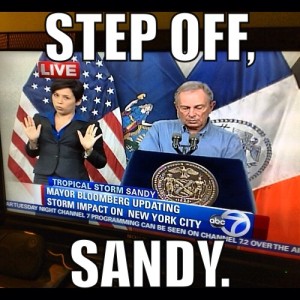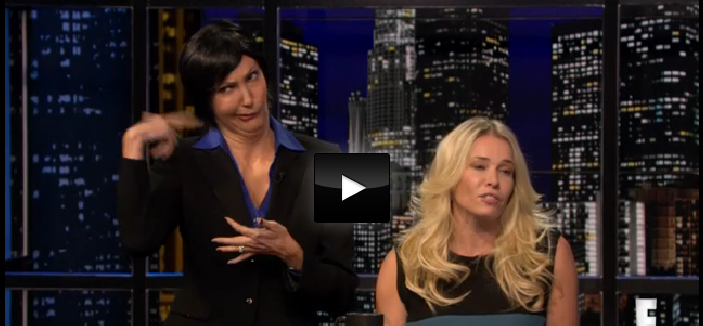Seeing is Disbelieving
 In the wake of Hurricane Sandy, an unexpected celebrity has emerged – Lydia Callis, a sign language interpreter who appeared on-screen alongside Mayor Bloomberg during his warnings in advance of the hurricane (her name has also been widely reported as “Calas”). In the original videos, Callis used American Sign Language and vivid facial expressions to convey both the content and tone of Bloomberg’s speech. Her animated expressions quickly led to the creation of a Tumblr, a spoof on Chelsea Lately, an edit of her “many moods,” multiple videos setting her signing to music, and significant media coverage elsewhere.
In the wake of Hurricane Sandy, an unexpected celebrity has emerged – Lydia Callis, a sign language interpreter who appeared on-screen alongside Mayor Bloomberg during his warnings in advance of the hurricane (her name has also been widely reported as “Calas”). In the original videos, Callis used American Sign Language and vivid facial expressions to convey both the content and tone of Bloomberg’s speech. Her animated expressions quickly led to the creation of a Tumblr, a spoof on Chelsea Lately, an edit of her “many moods,” multiple videos setting her signing to music, and significant media coverage elsewhere.
Why so much attention? Some portions of the Deaf community have been happy to see that there was interest on the part of a hearing public, seeing an interpreter in a disaster situation for likely the first time, while others have argued that there was an immediate sexualization of Callis, and her emotiveness, which might not have attached to a male interpreter. Broadly, there is discomfort with the idea of an interpreter attaining a kind of celebrity, as they are called upon to act as intermediaries, not as messengers in their own right. Callis herself has rejected her new notoriety, arguing that she was simply doing her job for the audience in the room and on television, as she told reporters that “Hearing people tend to not understand that deaf people need those facial expressions.” Similarly, many interpreters and Deaf and hard-of-hearing Americans have seen this as a case in which ASL and non-hearing culture are being misunderstood or appropriated for humor.
Alongside these explanations and critiques, I want to suggest that all of these reactions are rooted in a media environment and audience experience in which access for people with disabilities, as well as access measures other non-mainstream ethnic or cultural groups, are regularly rendered invisible. Callis shattered that invisibility, her large gestures and expressive face demonstrating that media access could (and ought?) to be seen.
The invisibility of media access surrounds us; closed captions on television are hidden unless turned on, and the coding of a web page for a screenreader waits in the HTML to be activated by users or their assistive technologies. Media experiences, in their default forms, hide the measures needed to render themselves accessible to diverse audiences. Captions that are off, unless turned on, structure the media experience to be tailored to an able audience by default, and require those who need them to take action. Even the laws that govern media access, such as the recent 21st Century Communications and Video Accessibility Act, are nearly invisible except to specialists. Their aims are to increase access without dampening innovation – most often, this means that legal structures favor adding access as invisibly as possible. To return to captions, their optional nature and English language reinforce a normative media experience in the United States. Though laws require accessible transmission of emergency messages, it is rare to see this done in ASL, which is visible, non-optional, and not based on English language. It is rare, in short, for mainstream audiences to see access measures at work.
This invisibility of media access in many ways reflects a larger historical exclusion of disability and other forms of bodily variation from public view, public culture, and public politics. Disability and cultural and linguistic variation are not marginal to the American public, but when variations are made invisible to a mainstream audience, default abilities, means of access, and experiences of media are normalized.
 Lydia Callis broke through that invisibility. Difference was suddenly made centrally visible, and that, in turn, called into questions the normative media experience. If this is a rare glimpse of what inclusive media looks like, then the lack of inclusion is made suddenly undeniable. By seeing her public appearance as a confrontation of the normative media experience, we can better understand some of the more egregious reactions to Callis as attempted reinforcement of those norms. For instance, the Chelsea Lately sketch featured Chelsea Handler calling the interpreter “over-zealous” and distracting, before a woman came out to “interpret” Handler’s message, in a mock-sign language that involved grabbing her own breasts. What is interesting, however, is not just that Handler attempted a poor parody, but that this sketch deliberately targeted ASL interpreting as too feminine, too flamboyant, too different, and too distracting; it is funny only with the assumption that media access ought to be unseen. For Handler, and many others who responded, Callis was simply too visible. As a visible woman, she was sexualized. As a visible reminder of difference, she was mocked. And, as a visible media performer, she was granted a measure of instant celebrity.
Lydia Callis broke through that invisibility. Difference was suddenly made centrally visible, and that, in turn, called into questions the normative media experience. If this is a rare glimpse of what inclusive media looks like, then the lack of inclusion is made suddenly undeniable. By seeing her public appearance as a confrontation of the normative media experience, we can better understand some of the more egregious reactions to Callis as attempted reinforcement of those norms. For instance, the Chelsea Lately sketch featured Chelsea Handler calling the interpreter “over-zealous” and distracting, before a woman came out to “interpret” Handler’s message, in a mock-sign language that involved grabbing her own breasts. What is interesting, however, is not just that Handler attempted a poor parody, but that this sketch deliberately targeted ASL interpreting as too feminine, too flamboyant, too different, and too distracting; it is funny only with the assumption that media access ought to be unseen. For Handler, and many others who responded, Callis was simply too visible. As a visible woman, she was sexualized. As a visible reminder of difference, she was mocked. And, as a visible media performer, she was granted a measure of instant celebrity.
The sketch has already been taken down from YouTube and E! Online, after being criticized by the National Association for the Deaf, among others. It seems to still be available through Xfinity. Notably, in all its online forms, this clip lacked captions, in violation of recent accessibility laws, not that anyone would know that unless they went looking for opt-in access. Once again, it seems that the persistant invisibility of media access allows for it to be forgotten, by audiences and industries alike, except under exceptional circumstances. Callis’ moment of visibility may not be ideal for an interpreter wary of celebrity, but it is an important indication of what is often not seen in the mediated public sphere, and of how people react when confronted with what they usually do not see. As a necessary reminder of media access and audience diversity in a time of trouble, Callis did her job well.



Liz, thank you for this post. I spent last weekend at a translation studies conference, where people frequently invoked the metaphor of invisibility. (It’s a common metaphor largely because of Lawrence Venuti’s book The Translator’s Invisibility.) Translators are very conscious of the idea (according to some) that because their function is to transmit ideas rather than originate them (i.e., because they are mediators, not authors), they should be self-effacing. What your post does is add another dimension to the political aspect of invisibility — this is an important intersection (one that is unexplored, to my knowledge) between translation studies and disability studies.
What’s different, however, is that in translation studies, calls to make mediation visible are usually calls to make the people consuming translations aware of the foreignness of what they are consuming. Translations into English, for instance, that appear to present a foreign text as if it had been written in English have the effect of erasing markers of difference. There’s something paradoxical about erasing difference when the purpose of translation is to bring something foreign into a domestic sphere.
Here, though, it seems the politics of visibility has much less to do with the consumers of translation (who are certainly well aware of the mediation taking place) and everything to do with people able to understand the original, who are forced to recognize that the message they are receiving is also mediated. I doubt they would put it in these terms, but making fun of Callis seems to signal a deeper, unspoken unease with the mediated nature of communication. (Of course, it signals much more than that, as you point out.)
I hope you’ll write more on this. I’m going to have to think about the implications of this shift in focus, but I’m eager to hear more.
Thanks, Kyle. I actually finished writing this piece and ordered your book, because I realized I’m getting closer to issues of translation in my own work. Increasingly, as you say, I’m thinking about how access and translation reveal the constructedness of media experiences and the normalization of certain constructions to the exclusion of others. Hope to talk about it in person one of these days!